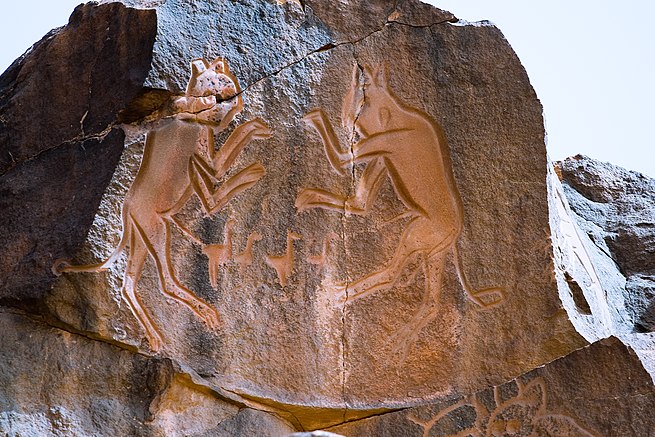
Main Difference
The main difference between Petroglyph and Hieroglyph is that the Petroglyph is a pictogram and logogram images carved on a rock surface and Hieroglyph is a pictographic sign.
-
Petroglyph
Petroglyphs are images created by removing part of a rock surface by incising, picking, carving, or abrading, as a form of rock art. Outside North America, scholars often use terms such as “carving”, “engraving”, or other descriptions of the technique to refer to such images. Petroglyphs are found worldwide, and are often associated with prehistoric peoples. The word comes from the Greek prefix petro-, from πέτρα petra meaning “stone”, and γλύφω glýphō meaning “to carve”, and was originally coined in French as pétroglyphe.
The term petroglyph should not be confused with petrograph, which is an image drawn or painted on a rock face. Both types of image belong to the wider and more general category of rock art or parietal art. Petroforms, or patterns and shapes made by many large rocks and boulders over the ground, are also quite different. Inuksuit are also unique, and found only in the Arctic (except for reproductions and imitations built in more southerly latitudes).
Another form of petroglyph, normally found in literate cultures, a rock relief or rock-cut relief is a relief sculpture carved on “living rock” such as a cliff, rather than a detached piece of stone. While these relief carvings are a category of rock art, sometimes found in conjunction with rock-cut architecture, they tend to be omitted in most works on rock art, which concentrate on engravings and paintings by prehistoric or nonliterate cultures. Some of these reliefs exploit the rock’s natural properties to define an image. Rock reliefs have been made in many cultures, especially in the Ancient Near East. Rock reliefs are generally fairly large, as they need to be to make an impact in the open air. Most have figures that are larger than life-size.
Stylistically, a culture’s rock relief carvings relate to other types of sculpture from period concerned. Except for Hittite and Persian examples, they are generally discussed as part of the culture’s sculptural practice. The vertical relief is most common, but reliefs on essentially horizontal surfaces are also found. The term relief typically excludes relief carvings inside natural or human-made caves, that are common in India. Natural rock formations made into statues or other sculpture in the round, most famously at the Great Sphinx of Giza, are also usually excluded. Reliefs on large boulders left in their natural location, like the Hittite İmamkullu relief, are likely to be included, but smaller boulders described as stele or carved orthostats.
-
Hieroglyph
A hieroglyph (Greek for “sacred writing”) was a character of the ancient Egyptian writing system. Logographic scripts that are pictographic in form in a way reminiscent of ancient Egyptian are also sometimes called “hieroglyphs”. In Neoplatonism, especially during the Renaissance, a “hieroglyph” was an artistic representation of an esoteric idea, which Neoplatonists believed actual Egyptian hieroglyphs to be. The word hieroglyphics refer to a hieroglyphic script. Only those privileged with an extensive education (i.e. the Pharaoh, nobility and priests) were able to read and write hieroglyphs; others used simpler ‘joined-up’ versions: demotic and hieratic script.
-
Petroglyph (noun)
A rock carving, especially one made in prehistoric times.
-
Hieroglyph (noun)
An element of an ideographic (hieroglyphic) writing system.
-
Hieroglyph (noun)
Any obscure or baffling symbol.
-
Hieroglyph (verb)
To represent by hieroglyphs.
-
Petroglyph (noun)
a rock carving, especially a prehistoric one.
-
Hieroglyph (noun)
a stylized picture of an object representing a word, syllable, or sound, as found in ancient Egyptian and certain other writing systems
“hieroglyphs describing the Mayan calendar”
-
Hieroglyph (noun)
a secret or incomprehensible symbol
“the International Organisation for Standardization is introducing two new hieroglyphs to perplex washing-machine owners”
